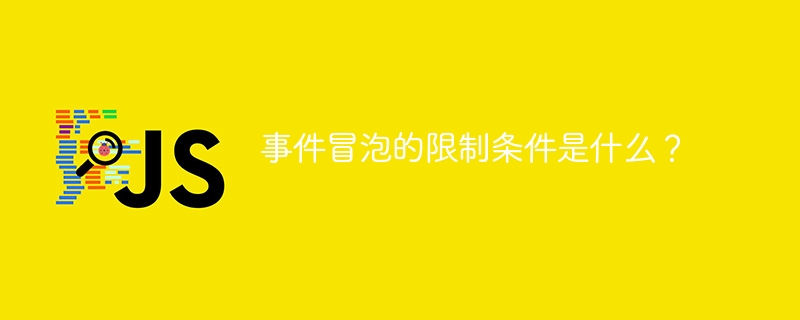Home >Web Front-end >JS Tutorial >What are the limiting conditions for event bubbling?
What are the limiting conditions for event bubbling?
- 王林Original
- 2024-01-13 08:59:17906browse

Event bubbling is a JavaScript event handling mechanism that allows a nested element to pass the event to its parent element when an event is triggered, and the parent element triggers the event in turn. The restrictions on event bubbling mainly include the following aspects.
First of all, event bubbling is the transmission from child elements to parent elements, but not all events support bubbling. Only certain event types, such as mouse events, keyboard events, and HTML form events, support event bubbling. Other event types, such as focus events and scroll events, do not support event bubbling.
Secondly, event bubbling can be prevented. When an element triggers an event, if you do not want the event to continue to be delivered and trigger the event handler of the parent element, you can use JavaScript's stopPropagation() method to prevent the event from bubbling. This method stops the propagation of events upward from the current element, thereby ensuring that only the current element's event handler is executed.
In addition, the delivery path of event bubbling is determined by the HTML structure. If there is a hierarchical relationship between nested elements, when an event is triggered, the event will be triggered step by step from the inside to the outside. If there is no hierarchical relationship between nested elements, that is, there is a parallel relationship between elements, when an event is triggered, the event will be triggered in the order in which the event handlers are added.
The following is a specific code example to illustrate the restrictions on event bubbling:
<!DOCTYPE html>
<html>
<head>
<title>事件冒泡示例</title>
</head>
<body>
<div id="outer">
<div id="inner">
<button id="button">点击按钮</button>
</div>
</div>
<script type="text/javascript">
var outerDiv = document.getElementById("outer");
var innerDiv = document.getElementById("inner");
var button = document.getElementById("button");
outerDiv.addEventListener("click", function() {
console.log("点击外层元素");
});
innerDiv.addEventListener("click", function() {
console.log("点击内层元素");
});
button.addEventListener("click", function(event) {
event.stopPropagation(); // 阻止事件冒泡
console.log("点击按钮");
});
</script>
</body>
</html>In the above code, when the button is clicked, the button, inner element and Click event handler for the outer element. But because the stopPropagation() method is used in the button's click event handler, only the button's own event handler will be executed. The output is: "Click the button". If you annotate the stopPropagation() method in the button click event handler, the output results will be: "Click the button", "Click the inner element", "Click the outer element". This example shows how to prevent event bubbling in code.
In summary, the limitations of event bubbling include event type support, the ability to prevent bubbling, and the delivery path determined by the HTML structure. In actual development, flexible use of the event bubbling mechanism according to needs and scenarios can effectively simplify code and improve interactivity.
The above is the detailed content of What are the limiting conditions for event bubbling?. For more information, please follow other related articles on the PHP Chinese website!
Related articles
See more- An in-depth analysis of the Bootstrap list group component
- Detailed explanation of JavaScript function currying
- Complete example of JS password generation and strength detection (with demo source code download)
- Angularjs integrates WeChat UI (weui)
- How to quickly switch between Traditional Chinese and Simplified Chinese with JavaScript and the trick for websites to support switching between Simplified and Traditional Chinese_javascript skills

